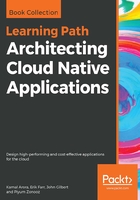
The Anatomy of Cloud Native Systems
In the first chapter, we identified that the promise of cloud-native is the ability for everyday companies to rapidly and continuously deliver innovation, with the confidence that the system will remain stable as it evolves and that it will scale to meet users' demands. Today's users demand far more than in the past. They expect to access applications around the clock from all kinds of devices, with zero downtime and sub-second response times, regardless of their geographic location. If any of these expectations are not met then they will seek out alternatives. Meeting these demands can seem daunting, but cloud-native empowers every day teams to deliver on this challenge. However, it requires us to approach software architecture with an open mind to new ways of thinking.
In this chapter, we begin our deep dive into the architectural aspects of cloud-native systems. In our definition, cloud-native is powered by disposable infrastructure, composed of bounded isolated components, scales globally, and leverages value-added cloud services. We put these technical concepts in context and pave the way for understanding cloud-native patterns. We will cover the following topics:
- The cloud is the database
- Reactive architecture
- Turning the database inside out
- Bulkheads
- Event streaming
- Polyglot persistence
- Cloud-native databases
- Cloud-native patterns
- Decomposition strategies for bounded isolated components